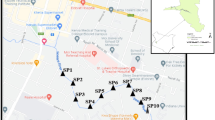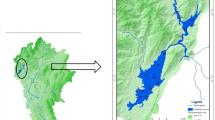Abstract
Solid waste dumpsites receive wastes containing pharmaceuticals and therefore serve as reservoirs of antibiotic residues. Leachates produced from dumpsites are among the principal means of transferring antibiotic residues into the aquatic and soil ecosystems. The occurrence, contamination level and ecotoxicological risk of three fluoroquinolone antibiotics (ciprofloxacin, norfloxacin and ofloxacin) in leachates from three dumpsites in Ibadan, South-Western Nigeria were investigated. An optimized quick, easy, cheap, effective, rugged and safe (QuEChERS) extraction was adopted for the extraction of target fluoroquinolones, extract was cleaned-up by dispersive-solid phase extraction while instrumental analysis was achieved using high performance liquid chromatography (HPLC). Risk quotient approach was used to estimate the potential ecotoxicological risk of target fluoroquinolone antibiotics to aquatic organisms at three trophic levels (algae, daphnid and fish). Recoveries ranged from 102–128%. Method limits of quantification were 0.35, 1.91 and 11.69 μg L−1 for norfloxacin, ciprofloxacin and ofloxacin, respectively. Inter-day precision (% RSD) ranged from 7–22%. High levels of studied fluoroquinolones were quantified, up to 796 μg L−1 for ofloxacin in leachates from Aba-Eku dumpsite. Based on chronic (long-term) toxicity data, norfloxacin in the leachates posed high risk to the three aquatic organisms. Ciprofloxacin presented moderate risk to algae in only Aba-Eku leachate in spite of the low risk observed for daphnids and fish in leachates from the three investigated dumpsites. Considering the high concentrations and potential risk of target fluoroquinolones in the leachates, groundwater resources around the investigated dumpsites should be monitored in future studies for these antibiotics and other pharmaceuticals.





Similar content being viewed by others
Data availability
Data will be made available on request.
Abbreviations
- QuEChERS:
-
Quick, easy, cheap, effective, rugged and safe
- HPLC:
-
High performance liquid chromatography
- LOQ:
-
Limit of quantification
- LOD:
-
Limit of detection
- RSD:
-
Relative standard deviation
- ARB:
-
Antibiotic resistant bacteria
- ARGs:
-
Antibiotic resistance genes
- SPE:
-
Solid phase extraction
- dSPE:
-
Dispersive solid phase extraction
- RQ:
-
Risk quotient
- MEC:
-
Measured environmental concentrations
- PNEC:
-
Predicted no effect concentrations
- NOEC:
-
No observed effect concentration
- PSA:
-
Primary and secondary amine
References
Maia AS, Paíga P, Delerue-Matos C, Castro PML, Tiritan ME (2020) Quantification of fluoroquinolones in wastewaters by liquid chromatography-tandem mass spectrometry. Environ Pollut 259:113927. https://doi.org/10.1016/j.envpol.2020.113927
Wang D, Ning Q, Dong J, Brooks BW, You J (2020) Predicting mixture toxicity and antibiotic resistance of fluoroquinolones and their photodegradation products in Escherichia coli. Environ Pollut 262:114275. https://doi.org/10.1016/j.envpol.2020.114275
Zhang R, Yang S, An YW, Wang YQ, Lei Y, Song LY (2022) Antibiotics and antibiotic resistance genes in landfills: a review. Sci Total Environ 806:150647. https://doi.org/10.1016/j.scitotenv.2021.150647
Kümmerer K (2009) Antibiotics in the aquatic environment—a review–part I. Chemosphere 75:417–434. https://doi.org/10.1016/j.chemosphere.2008.11.086
Sun Z, Lu Y, Zhu L, Liu W, Qu Y, Lin N, Yu P (2019) Simultaneous separation, concentration, and determination of trace fluoroquinolone antibiotics in environmental samples using a polymer aqueous two-phase system coupled with HPLC. J Chem Technol Biotechnol 94(9):2917–2927. https://doi.org/10.1002/jctb.6095
Mejías C, Santos JL, Martin J, Aparacio I, Alonso E (2023) Automatised on-line SPE-chiral LC-MS/MS method for the enantiomeric determination of main fluoroquinolones and their metabolites in environmental water samples. Microchem J 185:108217. https://doi.org/10.1016/j.microc.2022.108217
Sodhi KK, Singh DK (2021) Insight into the fluoroquinolone resistance, sources, ecotoxicity, and degradation with special emphasis on ciprofloxacin. J Water Process Eng 43:102218
Bhatt S, Chatterjee S (2022) Fluoroquinolone antibiotics: occurrence, mode of action, resistance, environmental detection, and remediation—a comprehensive review. Environ Pollut 315:120440
Pretali L, Fasani E, Sturini M (2022) Current advances on the photocatalytic degradation of fluoroquinolones: photoreaction mechanism and environmental application. Photochem Photobiol Sci 21:899–912. https://doi.org/10.1007/s43630-022-00217-z
Van Doorslaer X, Dewulf J, Van Langenhove H, Demeestere K (2014) Fluoroquinolone antibiotics: an emerging class of environmental micropollutants. Sci Total Environ 500–501:250–269. https://doi.org/10.1016/j.scitotenv.2014.08.075
Topal M, Topal EIA (2016) Determination and monitoring of tetracycline and degradation products in landfill leachate. Clean: Soil, Air, Water 44(4):444–450. https://doi.org/10.1002/clen.201400938
Yu X, Sui Q, Lyu S, Zhao W, Wu D, Yu G, Barcelo D (2021) Environ Sci Technol 55:4822. https://doi.org/10.1021/acs.est.0c07588
Ajibola AS (2016) Assessment of trace and major elements contamination in waste soils: leaching potential from active and closed landfills in Lagos, Nigeria. J Environ Earth Sci 6:8–15
Musson SE, Townsend TG (2009) Pharmaceutical compound content of municipal solid waste. J Hazard Mater 162:730–735. https://doi.org/10.1016/j.jhazmat.2008.05.089
Chung SS, Zheng JS, Burket SR, Brooks BW (2018) Select antibiotics in leachate from closed and active landfills exceed thresholds for antibiotic resistance development. Environ Int 115:89–96. https://doi.org/10.1016/j.envint.2018.03.014
Wu D, Huang ZT, Yang K, Graham D, **e B (2015) Relationships between antibiotics and antibiotic resistance gene levels in municipal solid waste leachates in Shanghai, China. Environ Sci Technol 49:4122–4128. https://doi.org/10.1021/es506081z
You XX, Wu D, Wei HW, **e B, Lu J (2018) Fluoroquinolones and beta-lactam antibiotics and antibiotic resistance genes in autumn leachates of seven major municipal solid waste landfills in China. Environ Int 113:162–169. https://doi.org/10.1016/j.envint.2018.02.002
Bai L, Tan Z, Gong H, Xu M, Li Z, Yue J, Liu L, Yang D, Li R (2022) Study on antibiotics, antibiotic resistance genes, bacterial community characteristics and their correlation in the landfill leachates. J Appl Microbiol 132:445–458. https://doi.org/10.1111/jam.15229
Wang Z, Wang Y, Tian H, Wei Q, Liu B, Bao G, Liao M, Peng J, Huang X, Wang L (2019) High through-put determination of 28 veterinary antibiotic residues in swine wastewater by one-step dispersive solid phase extraction sample cleanup coupled with ultra-performance liquid chromatography-tandem mass spectrometry. Chemosphere 230:337–346. https://doi.org/10.1016/j.chemosphere.2019.05.047
Kachhawaha AS, Nagarnaik PM, Jadhav M, Pudale A, Labhasetwar PK (2017) Optimization of a modified QuEChERS method for multiresidue analysis of pharmaceuticals and personal care products in sewage and surface water by LC-MS/MS. J AOAC Int 100(3):592–597. https://doi.org/10.5740/jaoacint.17-0060
Ajibola AS, Amoniyan OA, Ekoja FO, Ajibola FO (2021) QuEChERS approach for the analysis of three fluoroquinolone antibiotics in wastewater: Concentration profiles and ecological risk in two Nigerian hospital wastewater treatment plants. Arch Environ Contam Toxicol 80:389–401. https://doi.org/10.1007/s00244-020-00789-w
Ajibola AS, Awoyemi TE, Fasogbon OT, Adewuyi GO (2022) QuEChERS-based analysis and ecotoxicological risk of select antibiotics in dumpsite leachates, hospital wastewater and effluent receiving water in Ibadan, Nigeria. J Environ Sci Health A Toxic/Hazard Subst Environ Eng 57(8):709–722. https://doi.org/10.1080/10934529.2022.2104064
Olarinmoye O, Bakare A, Ugwumba O, Hein A (2016) Quantification of pharmaceutical residues in wastewater impacted surface waters and sewage sludge from Lagos, Nigeria. J Environ Chem Ecotoxicol 8:14–24. https://doi.org/10.5897/JECE2015.0364
Ogunbanwo OM, Kay P, Boxall AB, Wilkinson J, Sinclair CJ, Shabi RA, Fasasi AE, Lewis GA, Amoda OA, Brown LE (2022) High concentrations of pharmaceuticals in a Nigerian river catchment. Environ Toxicol Chem 41:551–558. https://doi.org/10.1002/etc.4879
Hu LX, Olaitan OJ, Li Z, Yang YY, Chimezie A, Adepoju-Bello AA, Ying GG, Chen CE (2021) What is in Nigerian waters? Target and non-target screening analysis for organic chemicals. Chemosphere 284:131546. https://doi.org/10.1016/j.chemosphere.2021.131546
Nikolopoulou V, Ajibola AS, Aalizadeh R, Thomaidis NS (2023) Wide-scope target and suspect screening of emerging contaminants in sewage sludge from Nigerian WWTPs by UPLC-qToF-MS. Sci Total Environ 857:159529. https://doi.org/10.1016/j.scitotenv.2022.159529
Ajibola AS, Zwiener C (2022) Occurrence and risk assessment of antibiotic residues in sewage sludge of two Nigerian hospital wastewater treatment plants. Water Air Soil Pollut 233:405. https://doi.org/10.1007/s11270-022-05875-4
Ajibola A, Olatunji D, Bayode O (2022) Occurrence of veterinary antibiotics in poultry manure from two farms in Ibadan, Nigeria: ecotoxicological implications in manure-amended soil. Environ Anal Health Toxicol 37(4):e2022038. https://doi.org/10.5620/eaht.2022038
Wei D, Kisuno A, Kameya T, Urano K (2006) A new method for evaluating biological safety of environmental water with algae, daphnia and fish toxicity ranks. Sci Total Environ 371:383–390. https://doi.org/10.1016/j.scitotenv.2006.08.038
Ebert D (2022) Daphnia as a versatile model system in ecology and evolution. EvoDevo 13:16. https://doi.org/10.1186/s13227-022-00199-0
European Commission (2003) Technical guidance document in support of commission directive 93/67/EEC on risk assessment for new notified substances and commission regulation (EC) No. 1488/94 on risk assessment for existing substances, part II, Brussels, Belgium
Rodriguez-Mozaz S, Vaz-Moreira I, Giustina SVD, Llorca M, Barceló D, Schubert S, Berendonk TU, Michael-Kordatou I, Fatta-Kassinos D, Martinez JL, Elpers C, Henriques I, Jaeger T, Schwartz T, Paulshus E, O’Sullivan K, Pärnänen KMM, Virtam M, Do TT, Walsh F, Manaia CM (2020) Antibiotic residues in final effluents of European wastewater treatment plants and their impact on the aquatic environment. Environ Int 140:105733. https://doi.org/10.1016/j.envint.2020.105733
Peysson W, Vulliet E (2013) Determination of 136 pharmaceuticals and hormones in sewage sludge using quick, easy, cheap, effective, rugged and safe extraction followed by analysis with liquid chromatography-time-of-flight-mass spectrometry. J Chromatogr A 1290:46–61. https://doi.org/10.1016/j.chroma.2013.03.057
Ajibola AS, Tisler S, Zwiener C (2020) Simultaneous determination of multiclass antibiotics in sewage sludge based on QuEChERS extraction and liquid chromatography-tandem mass spectrometry. Anal Methods 12:576–586. https://doi.org/10.1039/C9AY02188D
Sunyer-Caldú A, Diaz-Cruz MS (2021) Development of a QuEChERS-based method for the analysis of pharmaceuticals and personal care products in lettuces grown in field-scale agricultural plots irrigated with reclaimed water. Talanta 230:122302. https://doi.org/10.1016/j.talanta.2021.122302
Wang K, Reguyal F, Zhuang T (2021) Risk assessment and investigation of landfill leachate as a source of emerging organic contaminants to the surrounding environment: a case study of the largest landfill in **an City, China. Environ Sci Pollut Res 28:18368–18381. https://doi.org/10.1007/s11356-020-10093-8
Qiao L, Tao Y, Yao W, Zhao J, Yan Y (2022) A magnetic ionic liquid based vortex-assisted dispersive liquid–liquid microextraction coupled with back-extraction for the enrichment of fluoroquinolone antibiotics. J Pharm Biomed Anal 219:114903. https://doi.org/10.1016/j.jpba.2022.114903
Pochivalov A, Cherkashina K, Sudarkin A, Osmolowsky M, Osmolovskaya O, Krekhova F, Nugbienyo L, Bulatov A (2023) Liquid–liquid microextraction with hydrophobic deep eutectic solvent followed by magnetic phase separation for preconcentration of antibiotics. Talanta 252:123868. https://doi.org/10.1016/j.talanta.2022.123868
Lu D, Qin M, Liu C, Deng J, Shi G, Zhou T (2021) Ionic liquid-functionalized magnetic metal−organic framework nanocomposites for efficient extraction and sensitive detection of fluoroquinolone antibiotics in environmental water. ACS Appl Mater Interfaces 13:5357. https://doi.org/10.1021/acsami.0c17310
Zhao S, Sun Z, Liu H, Zhou Y, Li J, Wang X, Gong B (2019) Molecularly imprinted polymer coating on metal-organic frameworks for solid-phase extraction of fluoroquinolones from Water. J Sep Sci 42:3302–3310
Velpandian T, Halder N, Nath M, Das U, Moksha L, Gowtham L, Batta SP (2018) Un-segregated waste disposal: an alarming threat of antimicrobials in surface and groundwater sources in Delhi. Environ Sci Pollut Res 25:29518–29528. https://doi.org/10.1007/s11356-018-2927-9
Wang Y, Lei Y, Liu X, Song L, Hamid N, Zhang R (2022) Sulfonamide and tetracycline in landfill leachates from seven municipal solid waste (MSW) landfills: seasonal variation and risk assessment. Sci Total Environ 825:153936. https://doi.org/10.1016/j.scitotenv.2022.153
He P, Huang J, Yu Z, Xu X, Raga R, Lu F (2021) Antibiotic resistance contamination in four Italian municipal solid waste landfills sites spanning 34 years. Chemosphere. https://doi.org/10.1016/j.chemosphere.2020.129182
** H, Sun JZ, **e B (2018) The study of characteristics of antibiotic residues in municipal solid waste landfill. Acta Sci Circumst 38:300–309
Acknowledgements
We acknowledge the assistance rendered by the staff of the investigated dumpsites in samples collection.
Funding
This research did not receive any specific grant from funding agencies in the public, commercial or not-for-profit sectors.
Author information
Authors and Affiliations
Corresponding author
Ethics declarations
Conflict of Interest
The authors have declared no conflict of interest.
Supplementary Information
Below is the link to the electronic supplementary material.
Rights and permissions
Springer Nature or its licensor (e.g. a society or other partner) holds exclusive rights to this article under a publishing agreement with the author(s) or other rightsholder(s); author self-archiving of the accepted manuscript version of this article is solely governed by the terms of such publishing agreement and applicable law.
About this article
Cite this article
Ajibola, A.S., Agberotimi, J.B. & Obanubi, A.I. Occurrence and Ecotoxicological Impacts of Fluoroquinolone Antibiotics in Leachates from Three Nigerian Dumpsites. Chemistry Africa 7, 443–453 (2024). https://doi.org/10.1007/s42250-023-00748-7
Received:
Accepted:
Published:
Issue Date:
DOI: https://doi.org/10.1007/s42250-023-00748-7




